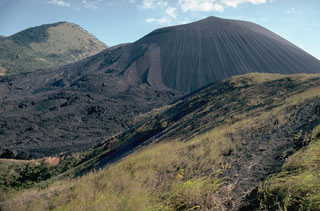Report on Cerro Negro (Nicaragua) — September 1993
Bulletin of the Global Volcanism Network, vol. 18, no. 9 (September 1993)
Managing Editor: Edward Venzke.
Cerro Negro (Nicaragua) Fumarolic activity along crater rim
Please cite this report as:
Global Volcanism Program, 1993. Report on Cerro Negro (Nicaragua) (Venzke, E., ed.). Bulletin of the Global Volcanism Network, 18:9. Smithsonian Institution. https://doi.org/10.5479/si.GVP.BGVN199309-344070
Cerro Negro
Nicaragua
12.506°N, 86.702°W; summit elev. 728 m
All times are local (unless otherwise noted)
Fumaroles observed during several visits to Cerro Negro on 2-5 September were issuing from circumferential fractures along the N rim of the crater and from feeder dikes in the base of the crater. Fumaroles along the crater rim exhibited weak and variable degassing, with temperatures ranging from 79 to 90°C. Stronger fumaroles remained confined to the feeder dikes within the crater. No attempt was made to enter the crater because of steep and unstable slopes. Little evidence of mass slumping of unconsolidated material from the crater wall was observed.
Geological Summary. Nicaragua's youngest volcano, Cerro Negro, was created following an eruption that began in April 1850 about 2 km NW of the summit of Las Pilas volcano. It is the largest, southernmost, and most recent of a group of four youthful cinder cones constructed along a NNW-SSE-trending line in the central Marrabios Range. Strombolian-to-subplinian eruptions at intervals of a few years to several decades have constructed a roughly 250-m-high basaltic cone and an associated lava field constrained by topography to extend primarily NE and SW. Cone and crater morphology have varied significantly during its short eruptive history. Although it lies in a relatively unpopulated area, occasional heavy ashfalls have damaged crops and buildings.
Information Contacts: Michael Conway and Andrew Macfarlane, Florida International Univ; Charles Connor, Southwest Research Institute; Oscar Leonel Urbina and Cristian Lugo, Instituto Nicaraguense de Estudios Territoriales (INETER), Nicaragua.

